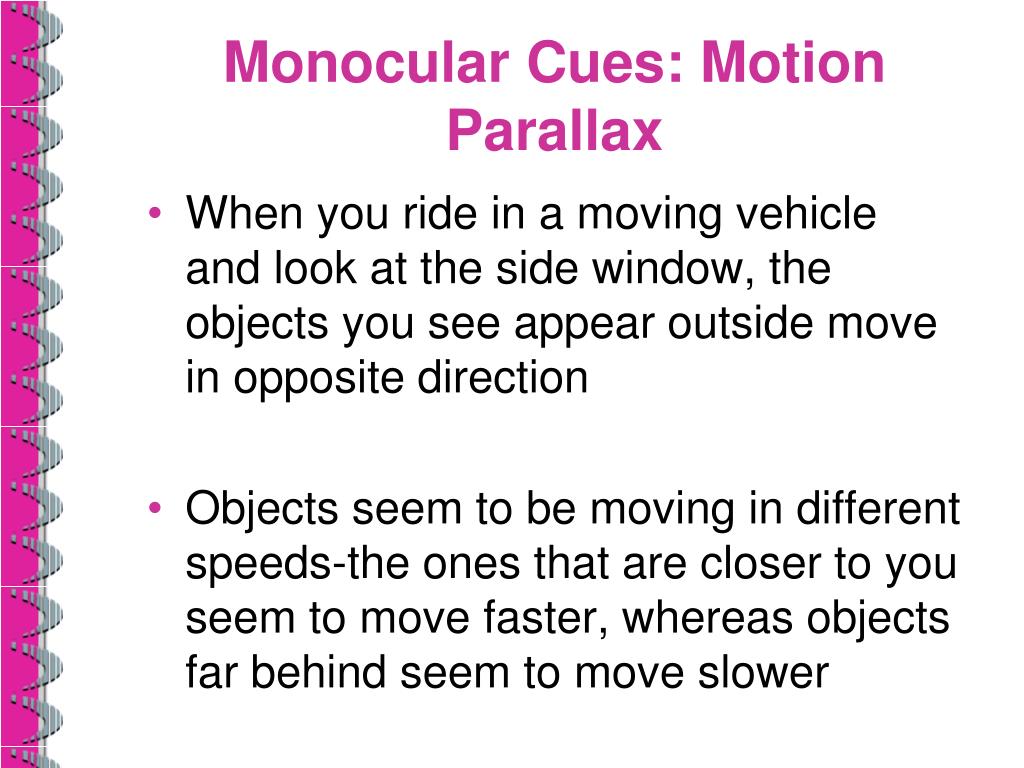
This technique is validated in additional experiments. This allows us to manipulate the disparity signal according to the strength of motion parallax to improve the overall depth reproduction. To measure the parallax and motion through space of a star Equipment: ruler, magnetic compass, scientific. We demonstrate how this model can be applied in the context of stereo and multiscopic image processing, and propose new disparity manipulation techniques, which first quantify depth obtained from motion parallax, and then adjust binocular disparity information accordingly. AS102 - Day Laboratory: Parallax Introduction - How can we find the distances to stars A method using radar measures the time delay between a pulse of radio waves sent to an object and the return of the reflected pulse, and. Based on the measurements, we propose a joint disparity-parallax computational model that predicts apparent depth resulting from both cues. To assess the strength of the effect we conduct psychovisual experiments that measure the influence of motion parallax on depth perception and relate it to the depth resulting from binocular disparity. We exploit the fact that in many practical scenarios, motion parallax provides sufficiently strong depth information that the presence of binocular depth cues can be reduced through aggressive disparity compression. In this work, we study the motion parallax cue, which is a relatively strong depth cue, and can be freely reproduced even on a 2D screen without any limits. For example, due to the low angular resolution of current automultiscopic screens, they can only reproduce a shallow depth range. However, in many scenarios, the range of depth that can be reproduced by this cue is greatly limited and typically fixed due to constraints imposed by displays. We conclude that absolute motion parallax only weakly determines the visual scale of nearby objects varying over a fourfold range in size.Starting from a stereoscopic video content with a static observer in a moving train (Left), our method detects regions where motion parallax acts as an additional depth cue (Center, white) and uses our model to redistribute the disparity depth budget from such regions (the countryside) to regions where it is more needed (the train interior) (Right).īinocular disparity is the main depth cue that makes stereoscopic images appear 3D.

Similarly, distance judgments varied by factors of only 1.74 and 1.07 respectively.

when angular size was held constant and motion parallax acted as a differential cue to target size and distance, judged size varied by a facto or 1.67 and 1.18 for the real and virtual environments, respectively, well short of the fourfold change in distal size.
#Motion parallax plus#
subjects moved laterally plus and minus 1 m to produce large amounts of motion parallax. the targets ranges in diameter from 3.7 cm to 14.8 cm and were viewed monocularly from difference distances, with a subset of the size/distance combinations resulting in projectively equivalent stimuli at the viewing origin. We had subjects judge the apparent size and distance of real and virtual objects under closely matched conditions Real and virtual targets were 4 spheres seen in darkness at eye level. We sought to assess the effectiveness of observer- produced motion parallax in scaling apparent size and distance within near space. It might be thought that the absolute motion parallax of stationary objects (both in real and virtual environments), under the assumption of the stationarity, would immediately determine their apparent size and distance for an observer who is walking about. The problem of visual scale under monocular viewing becomes readily apparent when one moves about within a virtual environment.

We exploit the fact that in many practical scenarios, motion parallax provides sufficiently strong depth information that the presence of binocular depth cues can be reduced through. The determinants of visual scale (size and distance) under monocular viewing are still largely unknown. In this work, we study the motion parallax cue, which is a relatively strong depth cue, and can be freely reproduced even on a 2D screen without any limits.


 0 kommentar(er)
0 kommentar(er)
